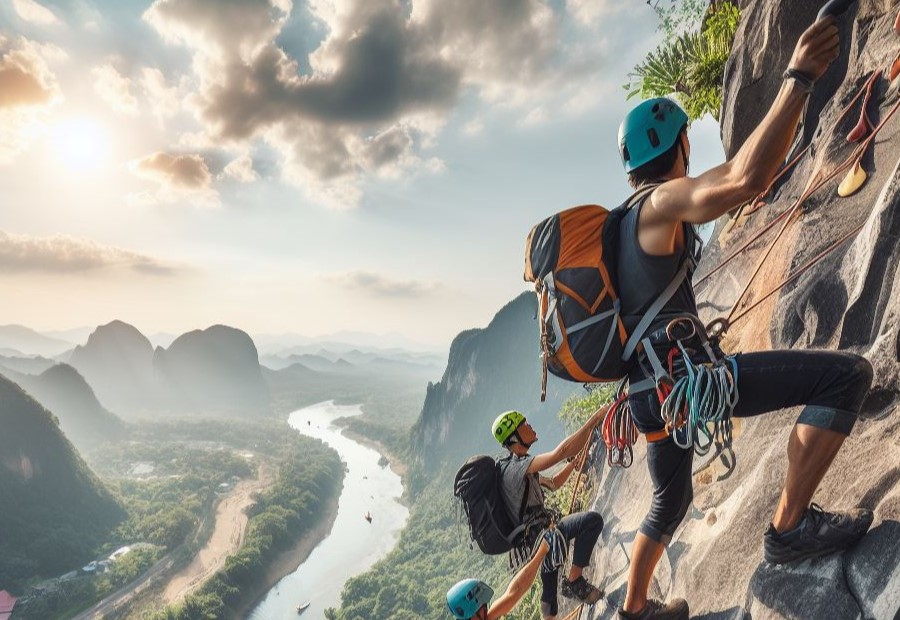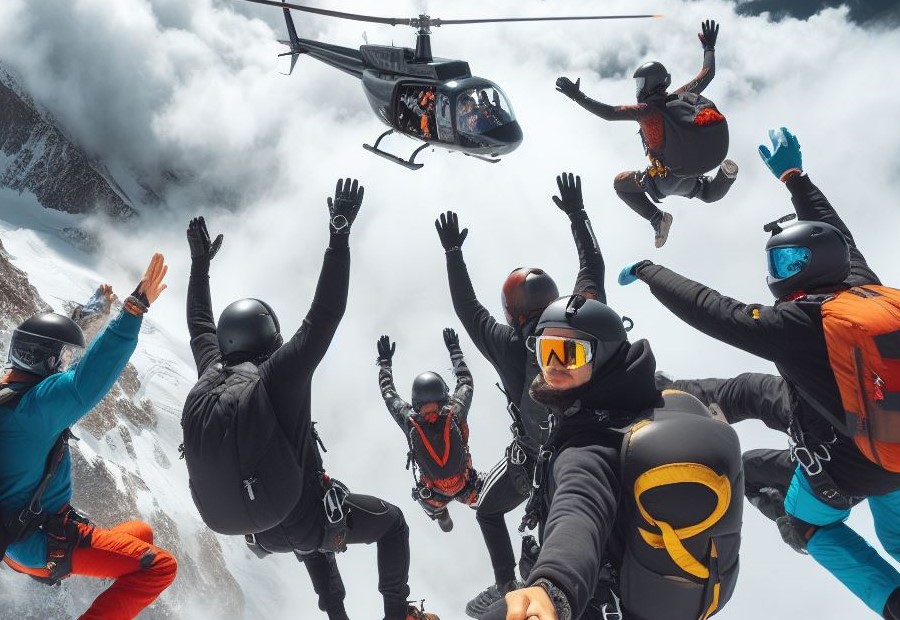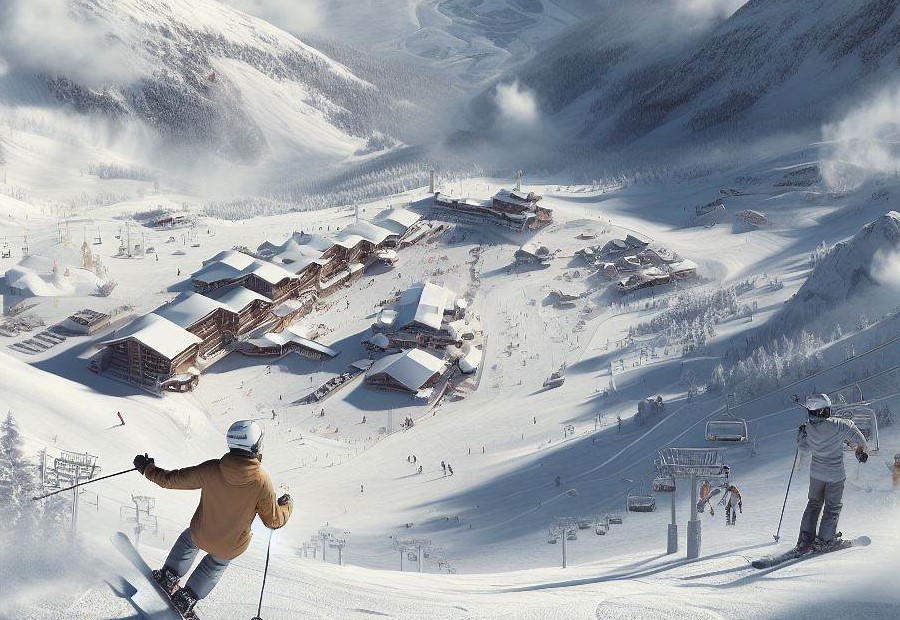Outdoor adventure sports offer thrilling and exhilarating experiences for individuals seeking excitement and a connection with nature. From scaling mountains to riding the waves, outdoor adventure sports provide a unique opportunity to challenge oneself physically and mentally.
In this article, we will explore the most popular outdoor adventure sports that people engage in. Some of these include hiking and mountaineering, rock climbing, surfing, mountain biking, skiing and snowboarding, white-water rafting, kayaking and canoeing, paragliding and hang gliding, skydiving, and zip-lining.
Each sport has its own adrenaline-pumping moments and unique experiences to offer. We will discuss the factors to consider when choosing an outdoor adventure sport, the benefits of participating in these activities, and provide useful tips for getting started.
So, if you’re ready to embrace the thrill of outdoor adventure sports, let’s dive in and explore the possibilities that await you!
What are the Most Popular Outdoor Adventure Sports?

Looking for an adrenaline rush in the great outdoors? We’ve got you covered. In this section, we’ll uncover the most popular outdoor adventure sports that will make your heart race and your spirit’s soar.
From hiking and mountaineering to surfing and skydiving, we’ll dive into the thrilling world of outdoor activities that are sure to get your blood pumping. Get ready to explore the heights, conquer the waves, and challenge yourself with these exhilarating pursuits.
Hiking and Mountaineering
When considering hiking and mountaineering as outdoor adventure sports, there are several factors to take into account:
- Physical fitness: Hiking and mountaineering require a certain level of physical fitness and endurance. It’s important to assess your fitness level and choose trails or mountains that match your abilities.
- Equipment: Proper gear is essential for hiking and mountaineering. Invest in a good pair of hiking boots, appropriate clothing for the weather conditions, a backpack to carry essentials, navigation tools such as a map and compass or GPS device, and safety equipment like trekking poles and a headlamp.
- Terrain: Consider the difficulty level of the trail or mountain you plan to hike or climb. Some trails are well-marked and maintained, while others may require technical skills like rock or ice climbing. Research the trail or mountain beforehand to ensure it aligns with your experience and abilities.
- Weather conditions: Check the weather forecast before heading out on a hike or climb. Be prepared for changes in weather and bring appropriate gear to stay warm and dry.
- Safety precautions: Familiarize yourself with safety protocols, such as telling someone your hiking plans, bringing enough food and water, and knowing how to navigate in case of emergencies. It’s also advisable to hike or climb with a partner or in a group for added safety.
Rock Climbing
Rock climbing is an exhilarating outdoor adventure sport that requires both physical strength and mental focus. Here are some key points to consider when engaging in rock climbing:
- Equipment: Ensure you have the necessary gear, including climbing shoes, a harness, a helmet, and carabiners. These items are essential for safety and stability while rock climbing.
- Training: Before attempting any serious rock climbing, it’s important to receive proper training. Take a course to learn the basics of climbing techniques, safety procedures, and how to use rock climbing equipment effectively.
- Physical Fitness: Rock climbing requires strength, endurance, and flexibility. Make sure you are physically fit and engage in regular exercises that target your upper body, core, and grip strength.
- Routes and Ratings: Familiarize yourself with the different rock climbing routes and ratings. Routes are graded based on difficulty, ranging from beginner-friendly routes (5.5-5.8) to extremely challenging ones (5.11+). Start with easier routes and gradually progress as you gain experience and strength.
- Safety: Safety should always be a top priority when rock climbing. Practice proper belaying techniques, double-check knots, and communicate clearly with your climbing partner. Always climb with a buddy and pay attention to your surroundings.
- Mental Focus: Rock climbing requires mental focus and problem-solving skills. Stay calm, assess each move carefully, and trust your instincts. Develop confidence in your rock climbing abilities while being aware of your limitations.
- Environmental Awareness: Respect the natural environment and follow Leave No Trace principles. Avoid damaging the rock surface or disturbing local wildlife. Leave the rock climbing area as you found it, or even cleaner.
- Community: Engage with the rock climbing community. Attend local rock climbing events, join a rock climbing gym, or connect with other rock climbers online. Building friendships and learning from experienced rock climbers can greatly enhance your rock climbing journey.
Surfing
Surfing is a popular outdoor adventure sport that involves riding waves on a surfboard. It requires good balance and coordination to navigate the waves.
Surfers often wear wetsuits to protect themselves from the cold water and to provide extra buoyancy. Surfing can be done in various locations, including beaches, reefs, and point breaks.
The size and shape of the waves can greatly impact the surfing experience. Surfing can be enjoyed by people of all ages and skill levels.
It is important to check the weather and surf conditions before heading out to ensure safety. Surfing can provide a thrilling adrenaline rush and a sense of freedom being in the water.
It is important to respect the ocean and follow proper surfing etiquette to ensure a positive experience for everyone.
Surfing can be a great way to connect with nature and enjoy the beauty of the ocean.
Mountain Biking
Mountain Biking is a thrilling outdoor adventure sport that provides numerous benefits. It offers an excellent cardiovascular workout, strengthens leg muscles, and improves overall fitness. Engaging in this activity regularly can enhance endurance and agility.
Moreover, mountain biking allows you to explore stunning trails in natural landscapes, providing a sense of tranquility and connection with nature. Additionally, it can boost mental well-being by reducing stress and improving mood.
When selecting mountain biking as your chosen outdoor adventure sport, it’s important to consider factors such as trail difficulty, bike features, and safety equipment. Opt for trails that match your skill level, whether you’re a beginner or an experienced rider.
Ensure your bike is suitable for off-road terrains and equipped with proper suspension and brakes. Wearing essential safety gear like a helmet, gloves, and protective clothing is crucial.
To maximize your mountain biking experience, consider joining a local biking group or community. This will allow you to learn new techniques and discover exciting trails. Always stay aware of your surroundings and follow trail etiquette.
Regularly maintaining your bike is important to ensure its performance and lifespan. By incorporating mountain biking into your outdoor adventure sports repertoire, you can enjoy the thrill of riding through nature while reaping the physical and mental benefits it offers.
So, get out there, explore the trails, and embrace the excitement of mountain biking.
Skiing and Snowboarding
When it comes to outdoor adventure sports, skiing and snowboarding are two of the most popular activities. Here are some key aspects to consider:
- Equipment: Both skiing and snowboarding require specific gear. Skiers use skis, poles, and boots, while snowboarders use a single board and boots. It’s important to choose the right equipment based on your skill level and preferences.
- Skills and Experience: Skiing and snowboarding require some level of skill and experience. Beginners might opt for lessons or guidance from experienced individuals to ensure safety and proficiency.
- Terrain: Consider the type of terrain you prefer for skiing or snowboarding. Some people enjoy groomed slopes, while others prefer off-piste or backcountry adventures. Make sure the area you choose caters to your preferred type of experience.
- Weather Conditions: Weather plays a crucial role in skiing and snowboarding. Check the weather forecast and snow conditions to ensure optimal safety and enjoyment. Fresh powder is ideal for those who love the thrill of untouched snow.
- Safety Measures: Always prioritize safety when participating in skiing and snowboarding. Wear appropriate protective gear such as helmets and goggles and follow all safety guidelines and rules provided by the resort or location.
- Resorts and Facilities: Research available ski resorts or snowboarding facilities and consider their amenities, services, and proximity to your location. Some resorts offer additional activities or accommodations that may enhance your overall experience.
Pro Tip: Whether you choose skiing or snowboarding, remember to have fun and enjoy the adrenaline rush that comes with these exhilarating outdoor adventure sports!
White-Water Rafting
White-Water Rafting is an exhilarating outdoor adventure sport that involves navigating through rapids and currents in a raft. It offers a thrilling and adrenaline-pumping experience for adventure enthusiasts.
Safety is paramount in this sport, and participants are required to wear appropriate safety gear, such as helmets and life jackets.
White-Water Rafting can provide a sense of accomplishment and excitement as you work together as a team to conquer the rapids.
It requires physical strength and coordination, as you need to paddle vigorously and follow the instructions of the guide to maneuver the raft through the turbulent waters.
One important factor to consider when choosing White-Water Rafting is the difficulty level of the river. Rivers are classified into different grades based on their intensity, ranging from Class I (easy) to Class VI (extremely difficult and dangerous).
It is important to choose a river that matches your skill level and experience to ensure a safe and enjoyable experience.
Another factor to consider is the location of the White-Water Rafting adventure. Different rivers around the world offer unique and breathtaking scenery, adding to the overall experience.
Whether you prefer rafting through scenic canyons, dense forests, or snow-capped mountains, there are destinations worldwide that cater to your preferences.
Ultimately, White-Water Rafting provides an adrenaline rush and a chance to connect with nature in a thrilling and memorable way. It is an adventure sport that allows you to challenge yourself, bond with your fellow rafters, and create lasting memories.
So, if you’re looking for an exciting outdoor activity, White-Water Rafting is definitely worth considering.
Kayaking and Canoeing
- Kayaking and canoeing are popular outdoor adventure sports that involve paddling through water using different types of boats.
- These sports can be enjoyed on various types of bodies of water such as rivers, lakes, and even the ocean.
- Embarking on a kayaking or canoeing expedition provides a unique opportunity to explore stunning natural landscapes and observe wildlife firsthand.
- Achieving mastery in both sports requires physical strength and balance to maneuver the boats effectively.
- Kayaking involves the use of a narrow boat and a double-bladed paddle, allowing for faster speeds and greater control over the water.
- In contrast, canoeing employs a wider boat and a single-bladed paddle, providing stability and versatility.
- Whether you choose to embark on a kayaking or canoeing adventure individually or with a group, it is a great way to bond with friends and family while having fun.
- While these sports offer a thrilling and adventurous experience, it is crucial to prioritize safety at all times.
- It is essential to wear proper safety gear, including a life jacket, and stay informed about water conditions and potential hazards.
- From beginner-friendly calm waters to challenging rapids for experienced paddlers, both kayaking and canoeing can be tailored to different skill levels.
Paragliding and Hang Gliding
Paragliding and hang gliding are thrilling outdoor adventure sports that offer a unique perspective and adrenaline-pumping experience. Both activities involve flying in the air using different types of aircraft.
Paragliding, which is more popular, involves using a fabric wing and harness to glide through the air. It requires skills in controlling the wing and understanding wind patterns to stay in the air for longer durations.
Hang gliding, on the other hand, involves flying using a rigid, triangle-shaped wing. It requires a good sense of balance and control to maneuver the glider.
When considering paragliding or hang gliding as a sport, there are a few factors to consider.
Firstly, it is essential to receive proper training from certified instructors to ensure safety and learn the necessary techniques.
Secondly, check the weather conditions as it is crucial for a safe flight. Wind speed, direction, and thermal activity can greatly impact the experience.
Lastly, consider the location. Look for places with suitable launch sites and experienced pilots to guide you.
Participating in paragliding and hang gliding offers numerous benefits. It allows you to overcome fears, boost confidence, and experience a sense of freedom.
Additionally, it provides an opportunity to connect with nature, witness breathtaking views, and experience a unique thrill unlike any other.
If you’re seeking an adventure sport that combines flying and adrenaline, paragliding and hang gliding are excellent choices. Remember to prioritize safety, receive proper training, and enjoy the incredible feeling of soaring through the sky.
Skydiving
- Skydiving is an exhilarating and adrenaline-pumping outdoor adventure sport.
- Participants jump out of a plane or helicopter from high altitudes, typically around 12,000 to 15,000 feet.
- They free-fall through the air at speeds of around 120 miles per hour, experiencing an incredible rush.
- After a specified time, skydivers deploy their parachutes to slow down their descent and enjoy a peaceful canopy ride.
- Skydiving requires proper training and certification to ensure safety and proficiency.
For skydiving enthusiasts: If you’re new to the sport, start with tandem skydiving, where you’ll be attached to an experienced instructor throughout the jump. It’s a great way to experience the thrill of skydiving without the added responsibility of deploying your own parachute.
Zip-lining
Zip-lining is an exhilarating outdoor adventure sport that involves traversing through a series of cables or zip lines suspended between trees or other structures.
Participants are securely harnessed and attached to the zip line, allowing them to soar through the air at high speeds.
Zip-lining provides an adrenaline rush and a unique perspective of the surrounding scenery.
It requires a certain level of physical fitness and coordination, as participants need to control their speed and make smooth landings.
Before trying zip-lining, ensure that you meet the weight and age requirements set by the specific zip line course or operator.
Always follow the safety instructions provided by the guides or instructors to ensure a safe and enjoyable experience.
Did you know that the longest zip line in the world is located in the United Arab Emirates? The “Jebel Jais Flight” zip line spans over 2.83 kilometers (1.76 miles) and offers breathtaking views of the mountains and valleys below.
Factors to Consider when Choosing an Outdoor Adventure Sport

When choosing an outdoor adventure sport, there are several factors to consider:
- Physical fitness: Assess your fitness level and choose a sport that matches your abilities. Some sports, such as rock climbing or white-water rafting, require a higher level of physical fitness.
- Skill level: Consider your experience and skill level in the specific sport. If you’re a beginner, start with activities like hiking or kayaking before attempting more advanced sports like mountaineering or paragliding.
- Location: Take into account the availability of suitable locations for the sport. If you’re interested in skiing, for example, living near a ski resort or having access to snowy mountains is important.
- Risk tolerance: Evaluate your comfort level with taking risks. Some adventure sports, such as skydiving or bungee jumping, involve higher levels of risk compared to activities like cycling or trail running.
- Equipment and cost: Consider the equipment and gear required for the sport, as well as the associated costs. Activities like scuba diving or rock climbing may require special equipment and can be more expensive.
When considering an outdoor adventure sport, keep in mind your personal preferences and goals. Research different sports, seek guidance from experts, and try out various activities to find the one that suits you best.
Remember to always prioritize safety and follow proper training guidelines for any sport you choose.
What are the Benefits of Participating in Outdoor Adventure Sports?

Improved physical fitness: Outdoor adventure sports require physical exertion, which helps to improve overall fitness levels. Activities like hiking, rock climbing, and mountain biking are great for building strength, endurance, and cardiovascular health.
Mental well-being: Engaging in outdoor adventure sports can boost mental well-being by reducing stress and improving mood. Being surrounded by nature and participating in thrilling activities can provide a sense of relaxation and escapism.
Enhanced problem-solving skills: Adventure sports often involve overcoming obstacles and challenges. This helps to cultivate problem-solving skills, critical thinking, and the ability to adapt to new situations.
Increased self-confidence: Successfully participating in outdoor adventure sports can boost self-confidence and self-esteem. Overcoming fears and accomplishing goals can provide a sense of achievement and empowerment.
Connection with nature: Outdoor adventure sports allow individuals to connect with the natural environment. This can lead to a greater appreciation for nature, a desire to protect the environment, and a sense of awe and wonder.
Social interaction: Many outdoor adventure sports are best enjoyed with a group or team. Participating in these activities can enhance social connections, build relationships, and create memorable experiences with others.
Tips for Getting Started in Outdoor Adventure Sports

Here are some tips for getting started in outdoor adventure sports:
- Research different sports: Learn about various outdoor adventure sports and choose one that interests you.
- Start small: Begin with simpler activities like hiking or cycling to build your stamina and skills.
- Take lessons: Enroll in classes or hire a guide to learn the proper techniques and safety precautions.
- Invest in the right gear: Purchase or rent reliable equipment that suits the specific sport you’ve chosen.
- Join a community: Connect with like-minded individuals through clubs, forums, or social media groups to gain knowledge and support.
- Set realistic goals: Start with achievable targets and gradually challenge yourself to progress further.
- Practice regularly: Consistency is key, so make time for regular practice sessions to improve your performance.
- Stay safe: Prioritize safety by following guidelines, wearing appropriate protective gear, and being aware of your surroundings.
Fact: Outdoor adventure sports not only provide a thrilling experience but also offer numerous health benefits, including increased cardiovascular fitness and improved mental well-being.
Frequently Asked Questions
What are the most popular outdoor adventure sports?
The most popular outdoor adventure sports vary depending on the region and personal preferences.
However, some of the top activities include rock climbing, bungee jumping, canyoning, caving, cliff diving, coasteering, horseback riding, ice climbing, parkour, paragliding, scuba diving, skateboarding, skiing, skydiving, snowboarding, surfing, swimming, and windsurfing.
How has the COVID-19 pandemic affected outdoor recreation participation?
The COVID-19 pandemic has actually led to increased participation in outdoor recreation activities. With limited indoor activities available and a need for fresh air and exercise, more people have turned to outdoor adventures. This trend has been particularly noticeable among younger and more ethnically diverse crowds.
What are some popular winter sports for outdoor adventure?
Winter sports are a popular choice for outdoor adventure enthusiasts. Some of the top winter sports include skiing, snowboarding, snowshoeing, ice climbing, winter fat biking, and winter hiking. These activities provide a unique and thrilling experience in snowy and icy conditions.
Are there any risks associated with extreme sports and adventure activities?
Yes, extreme sports and adventure activities come with inherent risks. Participants can encounter various dangers such as falls, collisions, injuries, and even fatalities. It is crucial to follow safety guidelines, receive proper training, and use appropriate equipment to minimize these risks.
What are some popular activities to enjoy in national parks and forests?
National parks and forests offer numerous outdoor activities for visitors to enjoy. Some popular activities include hiking, camping, wildlife viewing, fishing, kayaking, canoeing, rafting, mountain biking, rock climbing, and horseback riding.
These activities allow individuals to connect with nature and experience the beauty of protected lands.
Where can I find detailed information and reports on outdoor recreation participation and market overview?
Detailed information and reports on outdoor recreation participation and market overview can be found through various reliable sources.
Websites such as the Outdoor Foundation, National Recreation and Park Association, and government agencies like the National Park Service provide comprehensive studies, surveys, and statistics on outdoor activities and trends.

